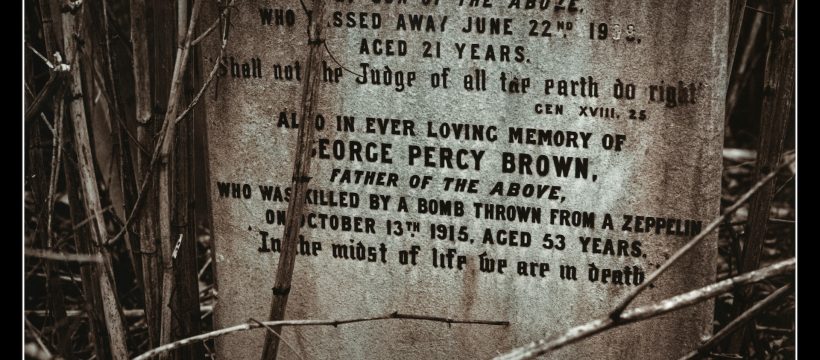Above: “Killed by a bomb thrown from a Zeppelin” – a photo I took in Abney Park Cemetery (Stoke Newington) in 1982.
At 11am on Sunday 11th Nov 2018, the 100th anniversary of the end WW1, the following local memorial events are being held:
- Garden of Remembrance Tower Hill,Trinity Square Gardens, adjacent to Tower Hill tube.
- Bethnal Green Gardens (near Bethnal Green Library)
- War memorial, Tower Hamlets Cemetery Park, Southern Grove, London E3
- Victoria Park (Cadogan Terrace) St Mark’s Gate, London E3 (informal commemoration)
More details on the Tower Hamlets website.
The background to Britain getting involved in WW1
The mainland European nations were in a constant state of tension, and all sorts of alliances were formed between them. Britain was protected from this by the sea, and had a fearsome Navy to defend itself. Kaiser Wilhelm II of Germany was Queen Victoria’s grandson. He attended a massive Royal Navy review off Spithead in 1899. He returned to Germany determined to build up his own fleet and Empire, which had only been formed in 1871.
In 1907 it was obvious that Germany had become a military threat and Britain joined France and Russia in a Triple Entente. Britain warned Germany that if it acted on General Schlieffen’s plan to invade France by sending their army though Belgium Britain would declare war on Germany. The Kaiser thought Britain was bluffing. Here’s what the Manchester Guardian said on 5th Aug 1914.
A very brief history of WW1
Belgium, France, Great Britain (plus the Dominion Forces of her Empire), and Portugal made a stand against the German attack. The battles across Belgium and France were called the Western Front because that’s what Germany had called it.
There were many battles and little appeared to be achieved for so many many dead and injured. But something was achieved – Germany was stopped from taking over Europe – until it all began again on 3rd Sept 1939.
Germany slowly lost WW1. On the 11th Nov 2018 the Armistice was signed in a railway carriage outside of Paris and at 11am on 11th November 1918 the guns fell silent. That day King George V and Queen Mary took an open carriage ride across London, stopping to shake hands with the public along the way. Newspapers declared: “Peace at Last”.
The effects of World War One on the East End of London
As soon as the war started food prices went up and families suffered hardship as their male breadwinners were sent to France in the army. Women began working in dangerous munitions factories.
During WWI German Zeppelin airships dropped bombs on the docks. Their bombing was not accurate. During the first air raid on London during WWI a bomb struck 16 Alkham Road, Hackney, during the night of 31st May 1915, killing 7 people and injuring 35. Later on 23rd Sept 1916 a direct hit destroyed the Black Swan pub opposite Bow Church killing five.
By June 1917 they were able to bomb from aircraft – Gotha bombers. A bomb hit Upper North Street School in Poplar killing 18 infants and injuring 37 more, some seriously.
Especially after the sinking of the Lusitania in 1915 there were anti German riots across London. The King of Prussia pub at Stratford was hurriedly renamed the King Edward.
The Casualties
The British Empire mobilised 8.9 million people. 900,000 were killed and 2 million were injured – some very seriously.
German had 11 million in its forces, 1.8 million were killed and 4.2 million were injured.
There were a total of 8.5 million armed forces deaths and 21 million injured. Plus there were lots of civilian casualties.


